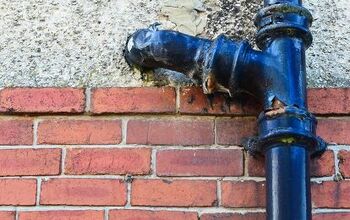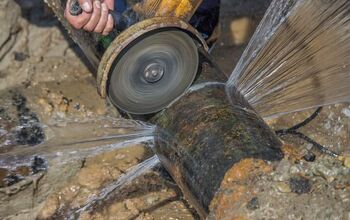Cast Iron Sewer Pipe Is Rusted And Leaking? (Do This!)

There are several things that most people are okay with leaking—details about favorite TV shows, news about a much-anticipated fashion line, things that people need to know. Sewer pipes? They’re not one of those things. In fact, a leaking sewer pipe is a serious health risk. Even cast iron sewer pipes can leak a pretty scary amount if left to rot. But, what can you do if your cast iron sewer pipe starts to leak?
If your cast iron sewer pipe is leaking, you can use the pipe bursting methods to replace your cast iron pipe. Or, you can use structural pipelining to fix it as long as the leaks are minor. If both of those methods fail, then traditional plumbing might be the only way to fix your problem.
Unlike most other outdoor plumbing issues, a corroded iron sewer pipe that’s sprung a leak is a serious problem. You need to address it today or as soon as you reasonably can. As someone who takes plumbing pretty seriously, here’s the advice that I can impart…
Do You Need to Hire a Plumber?
Get free, zero-commitment quotes from pro contractors near you.

How To Tell If Your Sewer Pipe Is Leaking
The first thing you should do is make sure that you have a leaking sewer pipe and not just a rusty pipe. Before you assume that you have a leaking pipe, look for these signs to confirm it below:
- Look for patches of extremely lush grass. Believe it or not, plants love sewage. It helps them grow. Unusually large, lush patches of grass are often a subtle sign of a leak.
- Check your walls for mold, bulges, or cracks. A crack in the wall suggests that there is some kind of damage to your foundation. If your sewer line collapsed or is leaking, this could cause a crack. Mold and bulges on your wall suggest that the sewer line (or water line, if you’re lucky) is leaking inside your home.
- Check for an uptick in insects and rodents. Both rodents and insects like sewage. If you notice them scurrying around your home, it could be due to a busted sewer pipe.
- Sniff around. Most leaky sewer pipes will exude a sewage smell, for obvious reasons.
- See if your pipes are draining slowly. A sewer pipe that’s leaking will cause your plumbing to drain slowly. A fast-draining pipe is a sign that your plumbing is intact.
- Look for signs of sinkholes or puddles. Collapsed or leaking pipes will cause sinkholes in driveways, dips in concrete, as well as puddles in your yard. Should you see these signs, it’s a clear sign that you’re dealing with a leak.
- You’ve noticed a marked change in the way that your sewer line is working. Any time you notice a strange issue with your plumbing, such as a lack of drainage or sudden backups, you might have a leak on your hand. Check with a plumber to find out what the matter could be.
What Can You Do To Fix A Rusted Iron Pipe That’s Leaking?
If you’ve noticed signs of a serious sewage leak in or around your home, it’s time to jump into action. There are three common solutions that you can choose, each of which has its own uses as well as its own technique. Each option is outlined below in plain English.
Using The Pipe Burst Technique
If you have a pipe that’s rusting away and gradually leaking out gunk, then you might want to use a pipe burst technique. Pipe bursting involves inserting a High-Density Poly-Ethylene pipe replacement into the iron pipe. The pipe has a bursting mechanism attached to a winch that helps break down the old pipe as it gets inserted into your plumbing.
Choosing to use this technique will give you a lot of benefits, including a low cost and a low cleanup time. You need to do minimal digging to do this, and the results last for ages. It also works with leaking pipes of almost every level of quality, including burst pipes that have serious seams running down the line.
Structural Pipe Lining
This option has been around since the 1970s and has gotten a fair amount of love in recent years because it involves no digging whatsoever. To do this, you will need to dip a felt liner into a specialty epoxy, then placing it in the cracked pipe. From there, the plumber will inflate the liner and leave it there for several hours to cure.
The line then gets removed, leaving your pipe crack-free. Since this is a method that is designed to fix cracks, it won’t work on totally broken or busted pipes. However, it’s a great go-to for anyone who is dealing with minor leaks.
Conventional Pipe Repair
Let’s say that your pipe isn’t just cracked. It’s just downright busted. We’re talking like, you can’t even feed a pulling cable through the pipe in order to string a new HDPE pipe into its place, busted. In these cases, pipelining or burst pipe techniques won’t work. Rather, you’re going to have to go the traditional route.
Conventional pipe repair is the most expensive option, and it also happens to be the most intrusive on your lawn. In many cases, doing conventional pipe repair means that you will have to set aside money for repairs to your lawn, your home, as well as cleanup endeavors.
How Much Does It Cost To Fix A Leaking Or Collapsed Sewer Line?
The price you should expect to pay will be based on the level of damage your line has, as well as the location of the damage. A leaking pipe of any sort will cost $150 to $350 at a bare minimum, not including the $250 to $750 you might need to pay to repair damage done to your drywall if it’s inside.
This is not the biggest price tag you might encounter. Collapsed sewer lines and other more advanced problems can cost anywhere from $1,100 for a simple collapse outside of the home to over $25,000 for extreme damage done to a sewer line. The sooner that you fix the leak, the less likely it is to turn into a five-figure repair.
Do You Need to Hire a Plumber?
Get free, zero-commitment quotes from pro contractors near you.

Related Questions
How should you maintain your sewer lines?
Sewer lines do not need much maintenance to stay in shape. Ideally, you will take the time to clean your sewer lines every 18 to 22 months. Professional plumbers can do this, or you can choose to use a high-grade liquid sewer line cleaner like Drano or an enzyme-based cleaner to do the job.
How long do cast iron sewer lines last?
If maintained well and left in good conditions, you can expect your cast iron sewer lines to last between 50 to 75 years. If neglected or placed in environments that are known for corrosion, the lifespan can shorten to 25 years or so. However, this is more of an exception than the rule.
What is the standard size for a sewer pipe?
A typical sewer pipe will have a four-inch diameter. However, each state and municipality has the right to reserve its own standard sizing based on the needs of the community. To find out the standard sizing for your area, check the local building codes.
Why do people prefer to do trenchless sewer line repair?
Most people prefer to use trenchless sewer line repair whenever it’s possible because it’s quick, low-cost, and doesn’t require much cleanup compared to more traditional methods. Though the repairs take a shorter amount of time, the repairs are still just as durable as the repairs done via the traditional route.
Are cast iron sewer lines the most durable sewer lines?
Contrary to popular belief, cast iron sewer lines are not the most durable lines in modern setups. PVC sewer lines are currently regarded as the most durable, cost-effective, and corrosion-proof material to use in sewer setups. Clay sewer lines are also noted for having a long lifespan, with many lasting over 100 years or so with proper care.
What causes leaks in cast iron sewer lines?
Corrosion and degradation are the most common culprits. However, it’s also possible to see a leak occur as a result of an earthquake. When the earth around a sewer line moves, it can jostle things around and even cause cracks.

Ossiana Tepfenhart is an expert writer, focusing on interior design and general home tips. Writing is her life, and it's what she does best. Her interests include art and real estate investments.
More by Ossiana Tepfenhart



























